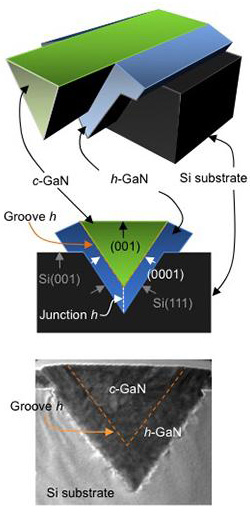- News
9 February 2017
LESA's Lighting and Displays team at RPI and University of New Mexico awarded patent for inexpensive growth of large-area cubic GaN
A team of faculty and graduate students at the Center for Lighting Enabled Systems & Applications (LESA) of Rensselaer Polytechnic Institute (RPI) of Troy, NY, USA and at the University of New Mexico (UNM) have been awarded US patent no. 9,520,472 ('Growth of Cubic Crystalline Phase Structure on Silicon Substrates and Devices Comprising the Cubic Crystalline Phase'). Cubic gallium nitride (GaN) devices hold promise for addressing two long-standing issues that limit the performance of light-emitting diodes (LEDs).
The research team and other investigators are working to develop LED manufacturing processes that will allow LEDs to shine brighter and in more colors. The material could be used in applications that include lighting for homes that would create brighter, more colorful, and efficient displays, as well as high-efficiency power electronics that are used to improve electric vehicles and renewable energy system performance.
According to the research team, LED performance is impacted by poor performance at longer emission wavelengths (the 'green gap' problem) and poor performance at higher operating current (efficiency droop). While GaN devices have excellent performance in the blue regions of the spectrum, these two technical problems limit the overall performance capability for future high-efficiency color-tunable lighting systems and advanced display technologies.
The patent was issued on 13 December to principal investigator Steven R.J. Brueck, distinguished professor emeritus with the UNM Department of Electrical & Computer Engineering (ECE) and UNM Center for High Technology Materials (CHTM) faculty member and director emeritus; and inventors Sueng-Chang Lee (UNM) and a team from Rensselaer. The Rensselaer/LESA team includes Christian Wetzel, professor of physics, applied physics, and astronomy and co-inventor of the patent; along with Theeradetch Detchprohm, who received his Ph.D. from Japan's Nagoya University and served as a research associate professor in the Future Chips Constellation; and Christoph Stark, who received a Ph.D. in physics from Rensselaer and now works for a startup company in Germany.
 Picture: LED manufacturing process enabling growth of cubic GaN on silicon substrates.
Picture: LED manufacturing process enabling growth of cubic GaN on silicon substrates.
By using a non-polar facet of cubic GaN, the research team has demonstrated emission across the visible spectrum from the cubic InGaN/GaN material system that offers significant opportunities for higher efficiency full-spectrum lighting and displays.
GaN crystals can be grown with either cubic or hexagonal (wurtzite) phases, but commercial GaN LEDs are based on hexagonal materials, typically grown on sapphire substrates. "The hexagonal phase typically forms most easily, as it is the lowest-energy crystallographic structure," says Wetzel. "Previous attempts to grow cubic GaN crystal structures have produced poor-quality, heavily defected mixed-phase materials," he adds.
"The patented UNM/RPI growth process uses inexpensive silicon wafers available in much larger sizes and lower defect densities than sapphire," says Brueck. "The silicon surface is first patterned with an array of nanoscale grooves that lead to a unique, geometrically driven phase segregation that separates the cubic phase and promotes its growth at the expense of the hexagonal phase GaN material," he adds. "Additional quantum well layers of InGaAs are added after the pure cubic phase GaN structure has been established to create the light-emitting material used to fabricate cubic LEDs."
The research at LESA exemplifies The New Polytechnic, an emerging paradigm for teaching, learning, and research at Rensselaer that emphasizes and supports collaboration across disciplines, sectors and regions to address global challenges by using the most advanced tools and technologies (many of which are developed at Rensselaer). Ultimately, LESA's vision is focused on creating digitized illumination for new applications in lighting, healthcare, building management, horticulture, and advanced 5G wireless communications platforms.


